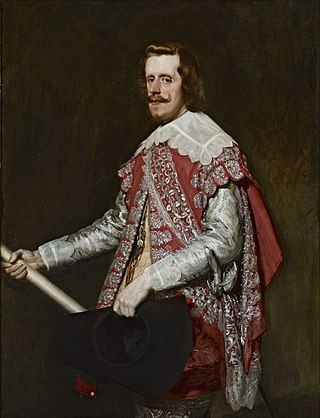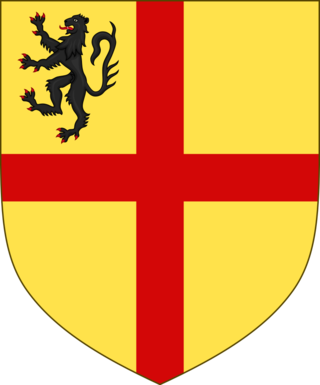Contents
| |||||
| Decades: | |||||
|---|---|---|---|---|---|
| See also: | Other events of 1621 List of years in Spain | ||||
This article needs additional citations for verification .(February 2024) |
Events in the year 1621 in Spain .
| |||||
| Decades: | |||||
|---|---|---|---|---|---|
| See also: | Other events of 1621 List of years in Spain | ||||
This article needs additional citations for verification .(February 2024) |
Events in the year 1621 in Spain .

The House of Habsburg, also known as the House of Austria, was one of the most prominent and important dynasties in European history.

Pope Gregory XV, born Alessandro Ludovisi, was the head of the Catholic Church and ruler of the Papal States from 9 February 1621 until his death in 1623. He is notable for founding the Congregation for the Propagation of the Faith, an organization tasked with overseeing the spread of Catholicism and missionary work. Gregory XV was also responsible for the canonization of Saints Ignatius of Loyola, Francis Xavier, Teresa of Ávila, and Philip Neri, which solidified his commitment to the Counter-Reformation.

1621 (MDCXXI) was a common year starting on Friday of the Gregorian calendar and a common year starting on Monday of the Julian calendar, the 1621st year of the Common Era (CE) and Anno Domini (AD) designations, the 621st year of the 2nd millennium, the 21st year of the 17th century, and the 2nd year of the 1620s decade. As of the start of 1621, the Gregorian calendar was 10 days ahead of the Julian calendar, which remained in localized use until 1923.

Philip III was King of Spain. As Philip II, he was also King of Portugal, Naples, Sicily and Sardinia and Duke of Milan from 1598 until his death in 1621.

Philip IV, also called the Planet King, was King of Spain from 1621 to his death and King of Portugal from 1621 to 1640. Philip is remembered for his patronage of the arts, including such artists as Diego Velázquez, and his rule over Spain during the Thirty Years' War.

Albert VII was the ruling Archduke of Austria for a few months in 1619 and, jointly with his wife, Isabella Clara Eugenia, sovereign of the Habsburg Netherlands between 1598 and 1621. Prior to this, he had been a cardinal, Archbishop of Toledo, viceroy of Portugal and Governor General of the Habsburg Netherlands. He succeeded his brother Matthias as reigning archduke of Lower and Upper Austria, but abdicated in favor of Ferdinand II the same year, making it the shortest reign in Austrian history.
King Philip may refer to

The counts of Holland ruled over the County of Holland in the Low Countries between the 10th and the 16th century.

The Treaty of London, signed on 18 August O.S. 1604, concluded the nineteen-year Anglo-Spanish War. The treaty restored the status quo between the two nations. The negotiations probably took place at Somerset House in Westminster and are sometimes known as the Somerset House Conference.

Francisco Gómez de Sandoval y Rojas, 1st Duke of Lerma, 5th Marquess of Denia, 1st Count of Ampudia, was a favourite of Philip III of Spain, the first of the validos through whom the later Habsburg monarchs ruled. His administration was marked by costly wars, including the Twelve Years' Truce with the Dutch Republic, financial mismanagement, and the controversial expulsion of the Moriscos. Eventually, he was deposed in 1618 under a palace intrigue orchestrated by his son and political rival, Cristóbal de Sandoval. Lerma retired as a cardinal and was succeeded by the Count-Duke of Olivares but faced financial penalties and died in 1625 at Valladolid.

Elisabeth of France, also known as Isabel or Elisabeth of Bourbon was Queen of Spain from 1621 to her death and Queen of Portugal from 1621 to 1640, as the first spouse of King Philip IV & III. She served as regent of Spain during the Catalan Revolt in 1640–42 and 1643–44. As the mother of the Queen of France Maria Theresa, wife of Louis XIV, she's the great-grandmother of the Duke of Anjou, who became king of Spain as Philip V. Through her daughter, Elisabeth is the progenitor of the Spanish branch of the House of Bourbon, which still rules over Spain to this day, as all future kings of Spain after the War of Spanish Succession descend from her. She's also the ancestor of the current Grand Duke of Luxembourg, Henri, through both the Bourbon-Parma collateral branch of the Spanish royal family and the main branch of Bourbon dynasty, as he is a descendant of the last Duke of Parma, Robert I, and his mother Louise of Artois, the granddaughter of Charles X of France, through Robert's son Felix.

The Pax Hispanica refers to a period of twenty-three years from 1598 to 1621, when Spain disengaged from the European wars of religion that characterised the previous century. Peace was signed with the Kingdom of France, the Kingdom of England, and the Dutch United Provinces. This roughly corresponds to the rule of Philip III of Spain.

The Twelve Years' Truce was a ceasefire during the Eighty Years' War between Spain and the Dutch Republic, agreed in Antwerp on 9 April 1609 and ended on 9 April 1621. While European powers like France began treating the Republic as a sovereign nation, the Spanish viewed it as a temporary measure forced on them by financial exhaustion and domestic issues and did not formally recognise Dutch independence until the Treaty of Westphalia in 1648. The Truce allowed Philip III of Spain to focus his resources elsewhere, while Archdukes Albert and Isabella used it to consolidate Habsburg rule and implement the Counter-Reformation in the Southern Netherlands.

Maria of Austria or Maria of Spain, also known as Isabel, was the empress consort and queen consort of Maximilian II, Holy Roman Emperor, King of Bohemia and Hungary. She served as regent of Spain in the absence of her father Emperor Charles V from 1548 until 1551 and was one of the most powerful empresses of the Holy Roman Empire.

The Count of Hainaut was the ruler of the county of Hainaut, a historical region in the Low Countries. In English-language historical sources, the title is often given the older spelling Hainault.

Roberto de Zúñiga y Velasco was a Spanish royal favourite of Philip III, his son Philip IV and a key minister in two Spanish governments. In control of foreign policy from 1618 to 1622, he was responsible for Spain's initially successful entry into the Thirty Years War (1618–1648) and for the appointment of his nephew, the Count-Duke of Olivares to the position of prime minister for much of the reign of Philip IV. De Zúñiga was also notable as being one of the very few Spanish royal favourites of the period to die whilst still in favour.

William Burke, Lord of Bealatury was an Irish noble and soldier who served in Spain, and later in Ireland during the Nine Years' War.
Decio Carafa (1556–1626) was an Archbishop of Naples who had previously served as papal nuncio to the Spanish Netherlands (1606–1607) and to Habsburg Spain (1607–1611).